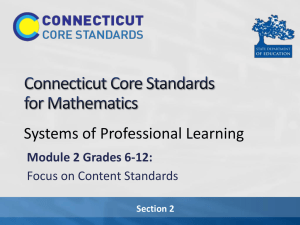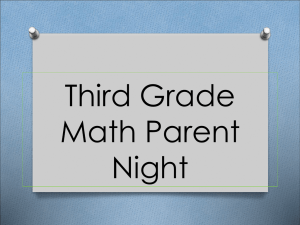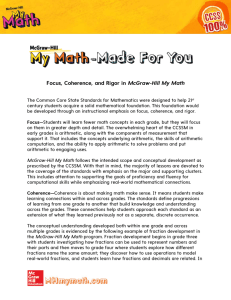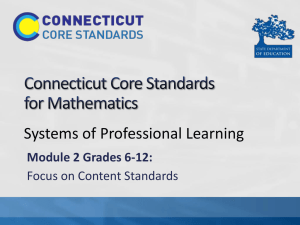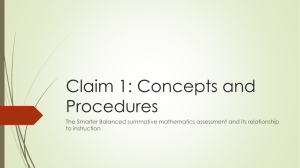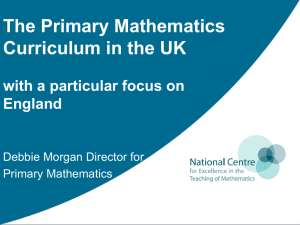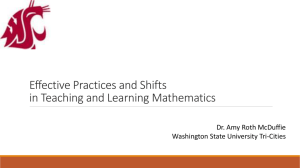Overview - Instructional Quality Commission (CA Dept of Education)
advertisement
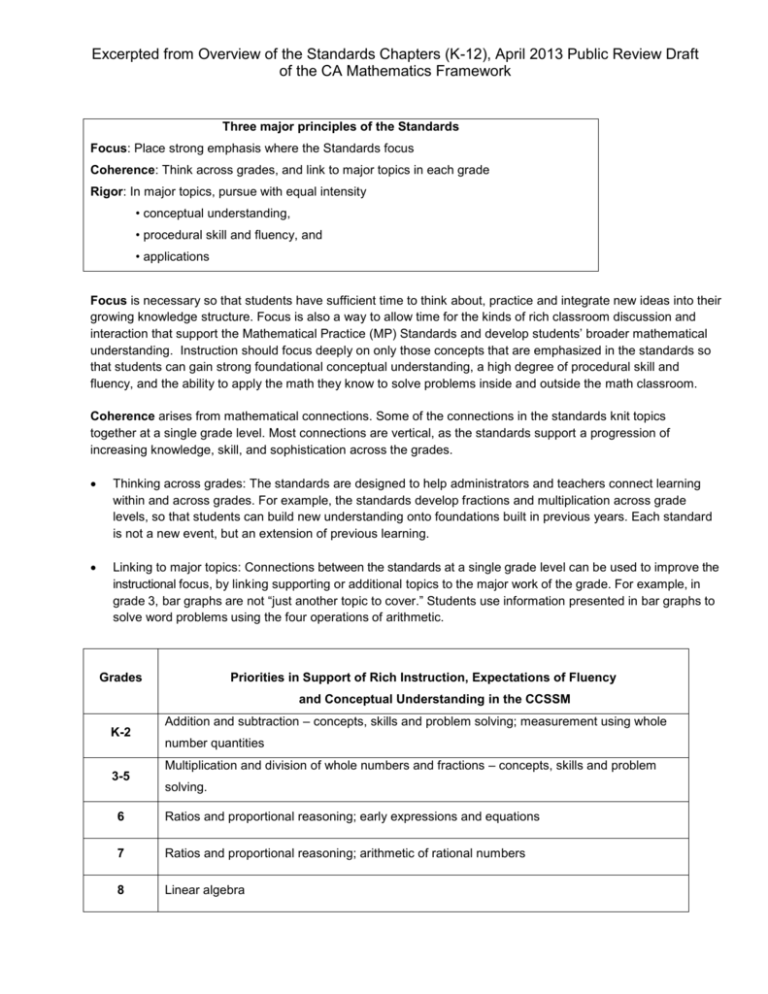
Excerpted from Overview of the Standards Chapters (K-12), April 2013 Public Review Draft of the CA Mathematics Framework Three major principles of the Standards Focus: Place strong emphasis where the Standards focus Coherence: Think across grades, and link to major topics in each grade Rigor: In major topics, pursue with equal intensity • conceptual understanding, • procedural skill and fluency, and • applications Focus is necessary so that students have sufficient time to think about, practice and integrate new ideas into their growing knowledge structure. Focus is also a way to allow time for the kinds of rich classroom discussion and interaction that support the Mathematical Practice (MP) Standards and develop students’ broader mathematical understanding. Instruction should focus deeply on only those concepts that are emphasized in the standards so that students can gain strong foundational conceptual understanding, a high degree of procedural skill and fluency, and the ability to apply the math they know to solve problems inside and outside the math classroom. Coherence arises from mathematical connections. Some of the connections in the standards knit topics together at a single grade level. Most connections are vertical, as the standards support a progression of increasing knowledge, skill, and sophistication across the grades. Thinking across grades: The standards are designed to help administrators and teachers connect learning within and across grades. For example, the standards develop fractions and multiplication across grade levels, so that students can build new understanding onto foundations built in previous years. Each standard is not a new event, but an extension of previous learning. Linking to major topics: Connections between the standards at a single grade level can be used to improve the instructional focus, by linking supporting or additional topics to the major work of the grade. For example, in grade 3, bar graphs are not “just another topic to cover.” Students use information presented in bar graphs to solve word problems using the four operations of arithmetic. Grades Priorities in Support of Rich Instruction, Expectations of Fluency and Conceptual Understanding in the CCSSM K-2 3-5 Addition and subtraction – concepts, skills and problem solving; measurement using whole number quantities Multiplication and division of whole numbers and fractions – concepts, skills and problem solving. 6 Ratios and proportional reasoning; early expressions and equations 7 Ratios and proportional reasoning; arithmetic of rational numbers 8 Linear algebra Excerpted from Overview of the Standards Chapters (K-12), April 2013 Public Review Draft of the CA Mathematics Framework Rigor requires that conceptual understanding, procedural skill and fluency, and application be approached with equal intensity. Conceptual understanding: The word “understand” is used in the standards to set explicit expectations for conceptual understanding. Teachers teach more than “how to get the answer” and support students’ ability to access concepts from a number of perspectives. Students might demonstrate deep conceptual understanding of core math concepts by solving short conceptual problems, applying math in new situations, and speaking and writing about their understanding. Students who lack understanding of a topic may rely on procedures too heavily. Without a flexible base from which to work, they may be less likely to consider analogous problems, represent problems coherently, justify conclusions, apply the mathematics to practical situations, use technology mindfully to work with the mathematics, explain the mathematics accurately to other students, step back for an overview, or deviate from a known procedure to find a shortcut. In short, a lack of understanding effectively prevents a student from engaging in the mathematical practices. Examples of Understanding in the CCSSM Grade Standards K Understand that each successive number name refers to a quantity that is one larger. (K.CC.4.c) 2 Understand that in adding or subtracting three-digit numbers, one adds or subtracts hundreds and hundreds, tens and tens, ones and ones; and sometimes it is necessary to compose or decompose tens or hundreds. (2.NBT.7) 4 Understand addition and subtraction of fractions as joining and separating parts referring to the same whole. (4.NF.3a) 6 Understand the concept of a ratio and use ratio language to describe a ratio relationship between two quantities. (6.RP.1) 8 Understand that a function is a rule that assigns to each input exactly one output. The graph of a function is the set of ordered pairs consisting of an input and the corresponding output. ( 8.F.1) Higher Mathematics Understand that a function from one set (called the domain) to another set (called the range) assigns to each element of the domain exactly one element of the range. (F-IF.1) Higher Mathematics Understand that by similarity, side ratios in right triangles are properties of the angles in the triangle, leading to definitions of trigonometric ratios for acute angles. (G-SRT.6) Excerpted from Overview of the Standards Chapters (K-12), April 2013 Public Review Draft of the CA Mathematics Framework Procedural skill and fluency: At various grade levels, specific content standards set expectations for fluency. “Fluently” is used in the standards to mean “reasonably fast and accurate” and the ability to use certain facts and procedures with enough facility that using them does not slow down or derail the problem solver as he or she works on more complex problems. Procedural fluency requires skill in carrying out procedures flexibly, accurately, efficiently, and appropriately. Developing fluency in each grade can involve a mixture of just knowing some answers, knowing some answers from understanding patterns and knowing some answers from understanding and using strategies. It is important to ensure that sufficient practice and extra support are provided at each grade to allow all students to meet the standards that call explicitly for fluency. Grade K Add/subtract within 5 1 Add/subtract within 10 2 Add/subtract within 20 (using strategies). Add/subtract within 100 (using strategies) 3 Multiply/divide within 100 (using strategies) Add/subtract within 1,000 (using strategies and algorithms) Add/subtract whole numbers within 1,000,000 (using the standard algorithm) 5 Multi-digit multiplication (using the standard algorithm) Add/subtract fractions 6 Multi-digit division (using the standard algorithm) Multi-digit decimal operations (add, subtract, multiply and divide using the standard algorithm for each operation). 7 Solve equations of the form 𝑝𝑥 + 𝑞 = 𝑟 and 𝑝(𝑥 + 𝑞) = 𝑟 4 Examples of Expectations of Fluency in the K-6 CCSSM Application: Students are expected to use mathematics to solve “real-world problems”. In the standards, the phrase “real-world problems” and the star symbol () are used to set expectations and flag opportunities for applications and modeling (which is a standard for mathematical practice as well as a conceptual category in higher mathematics). Real-world problems and standards that support modeling are also opportunities to provide activities related to careers and the work-world. Teachers in content areas outside of math, particularly science, ensure that students use mathematics – at all grade levels – to make meaning of and access content (adapted from Achieve the Core 2012).
